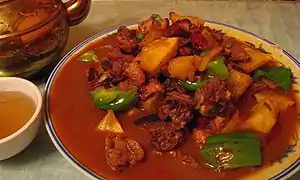Dapanji
Dapanji (Chinese: 大盘鸡; pinyin: Dàpánjī; lit. 'big plate chicken') or chong texse toxu qorumisi (Uighur: چوڭ تەخسە توخۇ قورۇمىسى, чоң тәхсә тоху қорумиси; also spelled qong təhsə tohu ⱪorumisi), is a type of chicken stew. It is a popular dish that originated in Xinjiang, China.

Etymology
Dapanji means "big plate chicken" in Chinese. In its Uyghur name, chong (چوڭ, Чоң, qong) means "big", texse (تەخسە, Тәхсә, təhsə) means "platter", toxu (توخۇ, Тоху, tohu) means "chicken" and qorumisi (قورۇمىسى, Қорумиси, ⱪorumisi) means "fried".
History
The dish gained popularity in Xinjiang in the mid-to-late 1990s. It is said to have been invented in Shawan, Northern Xinjiang, by a migrant from Sichuan who mixed hot chili peppers with chicken and potatoes in an attempt to reproduce a Sichuan taste.[1] Although Shawan is generally believed to the place of origin of the dish, there are also other claims of origin, including an invention by a Hunan native at Chaiwopu Lake near Ürümqi. Some believed the dish was originally served in a number of smaller plates, but later a large single plate was used instead which gave it its name. The dish was served by restaurateurs along the Xinjiang highways as a quick fix for truck drivers who often arrived at an odd time of the day. Its rich flavor and heartiness quickly made the dish a favorite of the region and the dish then spread to the rest of China.[2]
Ingredients and preparation
The main ingredients are chicken, bell peppers and potatoes, cooked with onions, garlic, ginger, chili peppers, ground cumin, star anise, ground Sichuan peppers, cooking oil, also optionally soy sauce and beer.[3]
The chicken is cut into bite size pieces (usually unboned), sautéed with spices and coarsely chopped vegetables and simmered in broth, providing a savory and spicy casserole-like dish. It is usually served with laghman (wide, hand-stretched noodles; known as latiaozi or kudaimian in China) and shared by family and friends in a communal manner.[4]
Other variations of the dish may be served with nan (馕包大盘鸡), a staple bread widely consumed in Xinjiang, usually served baked or roasted in Xinjiang restaurants and other places. With the sauce, the bread becomes very soft and moist, producing a melt-in-the-mouth savoury texture.
See also
References
| Wikimedia Commons has media related to Dapanji. |
- M Cristina Cesàro (2007). "Chapter 10, Polo, läghmän, So Säy: Situating Uyghur Food Between Central Asia and China". Situating the Uyghurs between China and Central Asia. Ashgate Publishing, Ltd. pp. 197–198. ISBN 978-0-7546-7041-4. Retrieved 2010-07-30.
- "新疆大盘鸡的"前世今生"". Hexun.com (in Chinese). 9 September 2011.
- Nate Tate, Mary Kate Tate (2011). Feeding the Dragon: A Culinary Travelogue Through China with Recipes. Andrews McMeel Publishing. p. 243. ISBN 978-1449401115.
- Chinese Cooking Demystified (2016-11-06). "Dapanji with Hand Pulled Kudaimian Noodles - Uyghur Big Plate Chicken (大盘鸡/چوڭ تەخسە توخۇ قورۇمىسى)". YouTube.